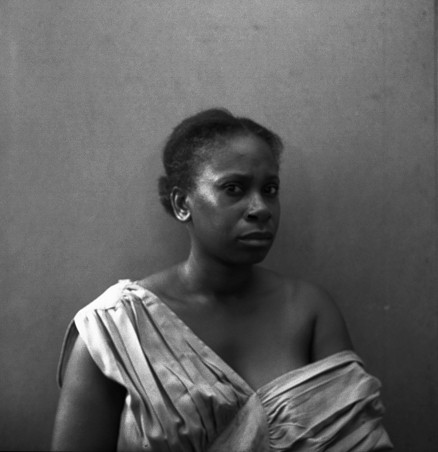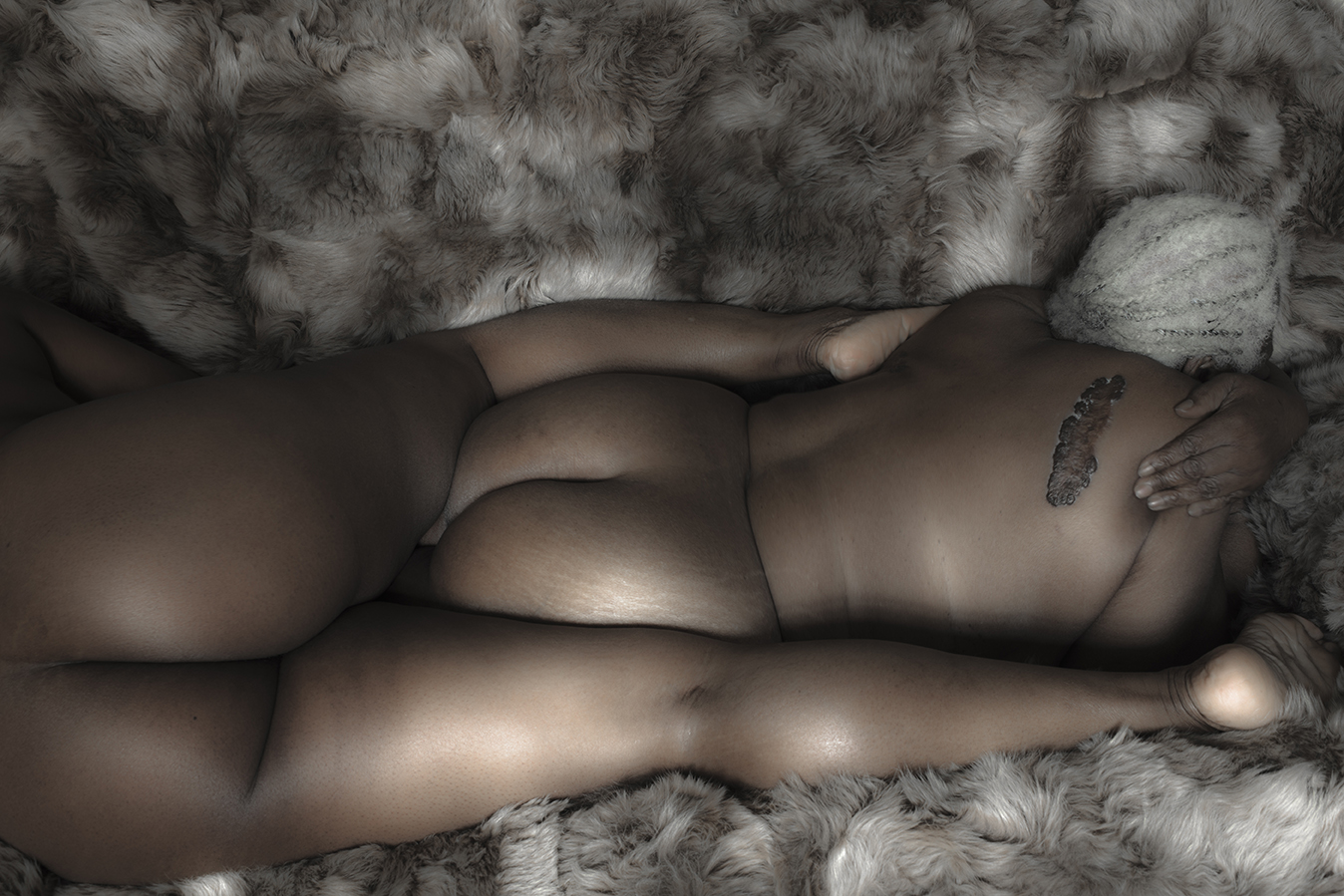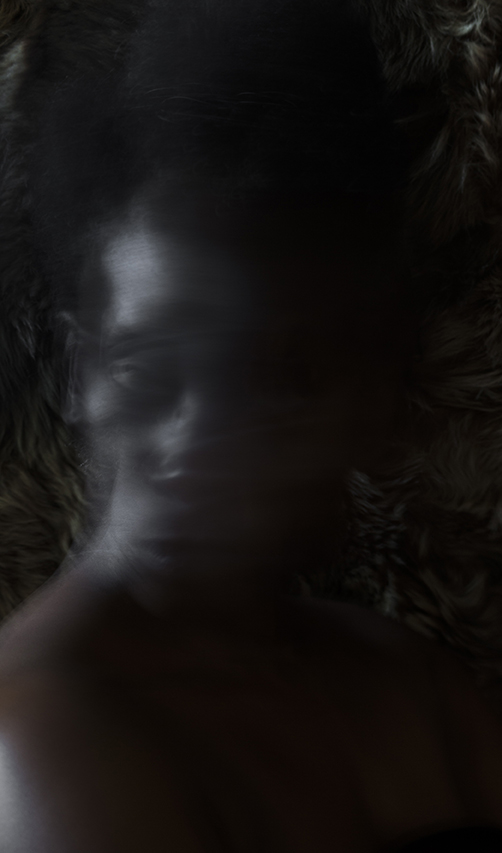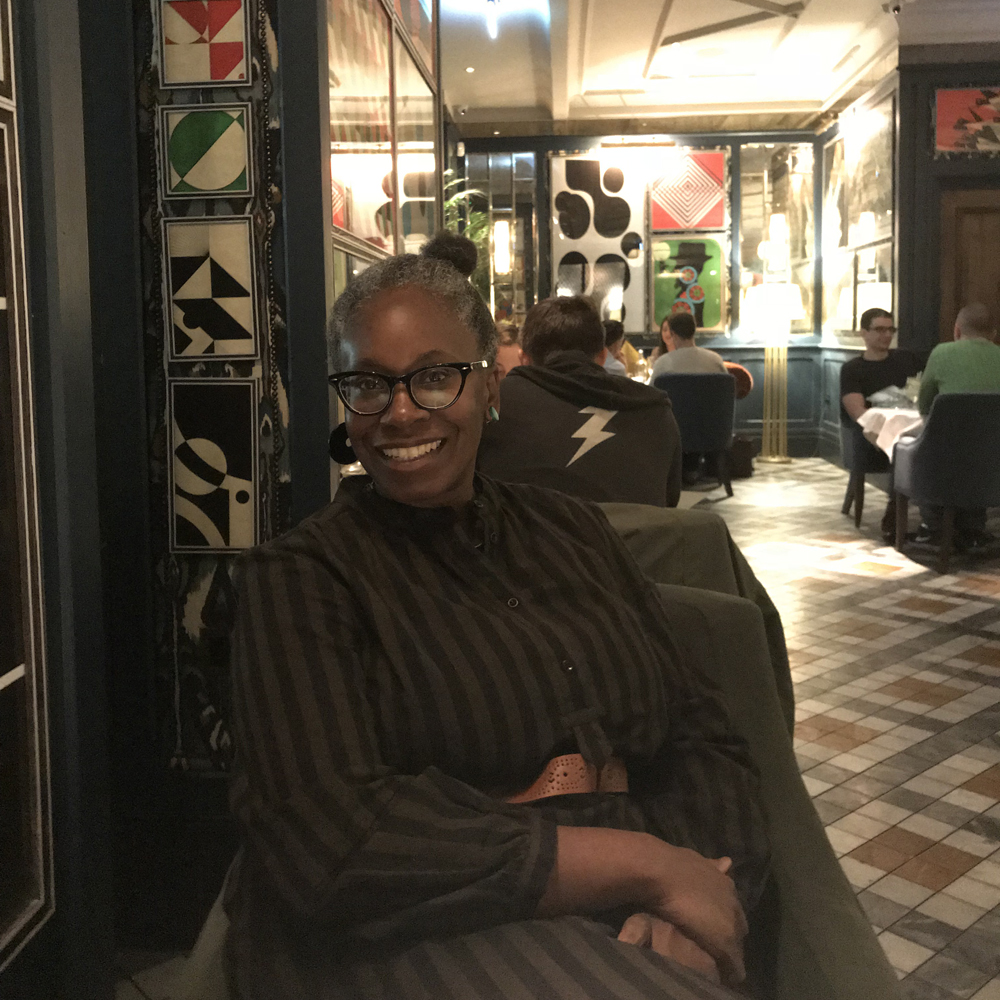Whether immortalised on canvas, shot through the glossy lens of magazines or filmed amidst the transient aura of fashion advertising, the body has always been prey to a particular and obsessive kind of scrutiny. Its representation through history has gone from one of liberation to shame, sexualisation to purity, fetishisation to disposability and privacy all the way to public ownership. Yet, in a market oversaturated with bodies in different states of dress and undress, what is it, that our flesh still conveys? What untold stories do the freckles and folds, wrinkles and wounds, crinkles and curves of our own bodies tell? Marcia Michael’s photography probes into the unwritten stories of our bodies: the body, its form and, most importantly, its history and narrative are displayed for us not just to look at, but instead to enter into a dialogue with. Photography as a means not just for representation but, specifically, to represent the voices of womanhood, motherhood and black identity.
There is something carnal in Marcia Michael’s photography, yet it somehow manages to move us independently of eroticism or voyeurism. What drives Michael to look at the body through the lens of a camera is her desire to know: “I am curious to see, to know, and therefore to share what I have found.” The subjecthood in her studies is displayed both traditionally, in the form of portraiture but, uncannily, it transpires most strikingly through her somewhat fractured, fleshy and macroscopic images. These images, often disembodied from our understanding of anatomy and juxtaposed to reminisce the texture of fabrics, reveal something beyond the mere corporeality of the skin almost inviting the viewer to take a step further, deeper into the lattice of our identity, history and our sense of belonging. “The work for a matrilineal recovery began because I could not find evidence of my matrilineal past, a past I searched the paper archives for, and could not find.” It is in this search – for meaning, answers, but also personal enrichment – that we too, find the missing pieces in our very own history and manage to see through the institutional screen society has shrouded us with. One of the most powerful aspects of Michael’s body of work, is its ability to reclaim the flesh from the scrutiny of the male white gaze. Historically, the act of photographing the flesh was confined to medical practitioners, whose male gaze became the focus in Foucault’s exposition of the ‘medical gaze’ in power dynamics. This act of looking, analysing and organising that is inherent in the gaze of the medical practitioner of the 19th and 20th century did not only signify clinical diagnoses but also the power dynamic between the male doctor and the patient especially in the context of the psychological or physiological examination. The scrutiny over the body, especially that of women and, more specifically, those of black women, resulted in furthering a dangerous, misogynist and racist interpretation of class, hierarchy and criminality that sadly still pervades society today. The history of the black body has been analysed as a medical specimen, an object to be studied and handled with white nitrile examination gloves but seemingly forgotten as a human being, rich in culture, tradition, history and narrative. When Michael set out to research the history of the black body, what she found was a lack of black female representation, a lack of the human and humane side of her black history: “I took it for granted that images and representations of Black families existed in books and in the photographic archives. As I began my research, I began to see the many ways in which these images could not be found. I also learnt that the educational institutions at that time did not point me into the right direction, and I was left wondering, if it was up to me to do the research.” Michael’s photography takes on what the patriarchal white gaze historically ignored, asking us to revisit instances in which our bodies have been scrutinised, overlooked or simply rejected by society. In this careful representation of the history academic books forgot to mention, Michael shares intimate but powerful moments of nostalgia, a yearning for what was left behind, forgotten, obliterated from the narrative of time: “the importance in being remembered, in some way, is what drives this work. The revealing of these moments via the photographic, connecting the past through the bodies of maternal histories, was an act I did not think was possible until I too began to feel them, my ancestors, in me, wanting to be visible – through me.”

Marcia Michael, Young Woman from The Study of Kin, (2009) © Courtesy of Artist
“The work for a matrilineal recovery began because I could not find evidence of my matrilineal past, a past I searched the paper archives for, and could not find.”
In her series ‘The Object of My Gaze’, Marcia makes her mother the subject and prime objective of her gaze. It is common for parents to diligently document, record and photograph the growth of their own children, but far less common for children to do the same thing to their parents. Society conditions us see youth as desirable and old age, especially in women, as something unflattering that should not be exposed, let alone photographed in all its wrinkled details. Yet, in Marcia’s case, it is not only about revealing the beauty of motherhood, but also, as she reminds us, an exercise in “the importance of making and the importance of showing images of Black women.”In fact, whilst photographers like Sally Mann, Nicholas Nixon and other white photographers showed images of their families, the need for Marcia to show hers was questioned during her academic life. “I can recall a tutor during my MA who commented why anyone would want to see images of my family. Was she being racist or was she just questioning the need for these images?” In this series, Marcia’s photography not only subverts the notion that mature bodies shouldn’t be seen but goes further, by tackling both the societal discomfort with old age and the societal ignorance of the aging black body. Her mother’s body is portrayed in all its complexity, power and tenacity. Her body is displayed unapologetically, her skin folds now appearing like beautiful drapes of textiles: velvet, luscious leather and veined slates of brown marble. Even in her mother’s nakedness, we don’t see an invasion of privacy nor a sexualised being – we see something powerful, full of knowledge, deeply rooted in a spatiotemporal cluster of memories, celebrations, defeats, laughters and nostalgic smells. We come closer to understanding, in Marcia’s own words, “what the experience of a Black person is.” Her mother’s nakedness is clothed with this shroud of wisdom, beauty and being that transcends the boundaries of the flesh almost to create an invisible but palpable trace around her reminiscent of Merleau-Ponty’s concept of the ‘flesh of the world’. In The Visible and the Invisible (Merleau-Ponty) the term ‘flesh’ becomes synonymous with an experience we feel, recognise or experience but fail to fully comprehend: “the flesh is not matter, it is not mind, is it not substance. To designate it, we should…speak of water, air, earth, and fire… the flesh is in this sense and ‘element’ of Being.” (The Visible and the Invisible, page 139) This flesh of the world, forgotten for far too long or simply obliterated from the consciousness of humankind, is captured here: “I am baffled by the fact that so many stories of Black people’s experiences when they arrived in the UK have not been told. This means that what the experience of the Black person is, is a catch up within a world in which they were not seen, but present for. Thus, there exists a world which has been constructed that was never really meant for Black people and yet, we have all been allowed to believe that we could fit in this world. However, if we don’t conform, or indeed if we overstep our place in this constructed world, we again, are made absent through various means.” This aura, this trace, which the Black history has left but very few people have managed to see is at the core of Marcia’s photography. At the very centre of her interrogation lies the reorganisation of the relationship between the history, personal narrative and consciousness of her matrilineage with the external world, inviting us viewers to do the same. “The Black body can only leave a trace and it is this very trace that I try and recapture as a memory in my works.” This concept of the trace – invisible to many but present for those who have been systematically forgotten by history – is best captured in Marcia’s series on the state of British psychiatric institutions. Here, all the images are eerily devoid of bodies, yet in that emptiness, in this lack, we finally see all the bodies forgotten by history – bodies, more often than not those of black women, confined to medical wards under false pretextes, against their will and with no power to exert their rights as human beings. For Marcia, these empty spaces work as “an analogy for the Black experience in and amongst white institutions”, the idea that where there is a gap, it is not always for lack of humans but sometimes for the lack of the very humane.
“The Black body can only leave a trace and it is this very trace that I try and recapture as a memory in my works.”
Marcia Michael probes into the connective tissue of matrilineal history by reclaiming the body from the scrutiny of scientific-style photography, patriarchal objectivity and social conditioning. The body is now something more than just an object to be analysed, but rather a subject to be reconciled with, celebrated and empowered. Through her photographic lens, the wholeness of the body is no longer defined by its biological unity but rather pieced together by the narrative, the story, the dialogue that we are now suddenly invited into. For Marcia, “knowing who we are and what we are has been expressed through various art forms and for me, the photographic image allows me simply to know how one body appears to be, so that when it is looked at, it begins a dialogue of multiple experiences, conversations and assumptions. This dialogue is what is important to me.”It is for this reason that despite the fact a lot of Marcia’s photographs show the body in various states of disembodiment, like in her series ‘Before Memory Returns’, the power of the flesh’s aura still enables us to see the humane, the lived, the experienced. The fragmented clinical bodies expertly labelled, ordered and stigmatised by the Galtons of the past centuries are now given a story, empowered, made human. Despite the fragmentation of the image, the body does not read as disembodied nor evocative of a very contemporary sense of dislocation. Marcia Michael’s photography might showcase the body as fragmented, but that’s only so we can recombine it, rehumanise it, reconnect it not only to itself but also to the centuries of black diaspora descendents culminating in the vital and urgent message that: to be fragmented does not mean loss of identity or sense of belonging, no, picking up where history books left off can be therapeutic. “I came to understand that there was a tradition between mother and daughter which was developed through the literary form (black literary matrilineage), that used this relationship to recover histories that were either lost, forgotten, or never spoken of. This retrieval was political and yet the method it took, was absolutely private. Toni Morrison (in Rootedness: The Ancestor as Foundation) makes this comment which makes so much sense to me, “It seems to me that the best art is political and you ought to be able to make it unquestionably political and irrevocably beautiful at the same time.” I do not strive to make the images appear to be a certain way for, what I do, is capture a moment of expression. Yet, within what is documented, is a sense of serenity, a sense of being and in some way, a sense of knowing. This most definitely has a therapeutic effect on the relationship between my mother and myself, but I hope it also has an effect on what images can do as a way to heal the past and also the future.”
The power in Marcia Michael’s photography comes in the form of a narrative wound with the filaments of our own bodies, histories and experiences. Through her black feminine gaze, Marcia seeks to rewrite, reclaim and open the dialogue surrounding how we perceive, understand and come to know our own history. As we are made partakers in her journey, we too begin to interrogate our place in society and dig deeper into who we really are and, most importantly, who we want to become.
By Gabriella Gasparini
all images © Marcia Michael













